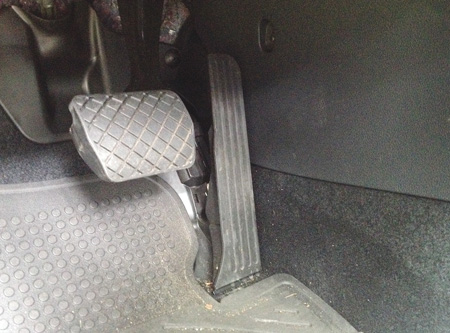May 29, 2015
ISSUE: Drivers use the brake almost a million times per year, usually with no problem. But each year, approximately 16,000 preventable crashes occur due to pedal error when drivers mistake the accelerator for the brake. Pedal error crashes can present serious safety risks to the vehicle occupants, surrounding motorists, pedestrians, and property.

Consumer Actions to Help Prevent Pedal Error Crashes
Frequently Asked Questions
What is Pedal Error and How Does It Occur?
Pedal error crashes can occur when:
This can cause sudden vehicle acceleration, often at full throttle, with no brake force slowing the vehicle down. These incidents are initiated most frequently in vehicles that are traveling at very low speeds, such as when attempting to park the vehicle in parking lots and driveways. They can also occur in other situations in which braking is commonly required, including intersections and highway exit ramps.
Many drivers recognize that a pedal error occurred after the incident, but are unable to correct the error in time to prevent a crash. This happens because once the initial pedal error occurs the situation develops rapidly, often in the confined space of a parking lot with drivers only having a few seconds to correct the issue while they are often startled and stressed by the unexpected acceleration of the vehicle.
How common are pedal error crashes and who do they generally happen to?
A NHTSA study shows that these crashes can occur up to 16,000 times per year in the United States – that’s almost 44 incidents per day. While these crashes can affect all drivers, the study shows that drivers under the age of 20 or over the age of 65 experience pedal error crashes about four times more frequently than other age groups.
How is pedal error related to “sudden acceleration”?
Sudden acceleration refers to unintended, unexpected, high power acceleration, accompanied by an apparent loss of braking effectiveness that typically occurs from a very low initial speed when the driver is attempting to stop the vehicle.
Investigations into reports of these incidents by NHTSA, NTSB and others during the past 40 years have not identified any vehicle defects that can cause sudden failures of both the throttle and braking systems and have attributed these complaints to pedal error by the driver.
Field investigations over the past five years by NHTSA and others using pre-crash pedal application data from vehicle event data recorders have determined that drivers who believed they were applying the brake in such incidents were often mistakenly applying the accelerator instead. Based on these investigations, NHTSA has not identified any defects with the vehicles that can explain simultaneous failures of the throttle and brake systems.